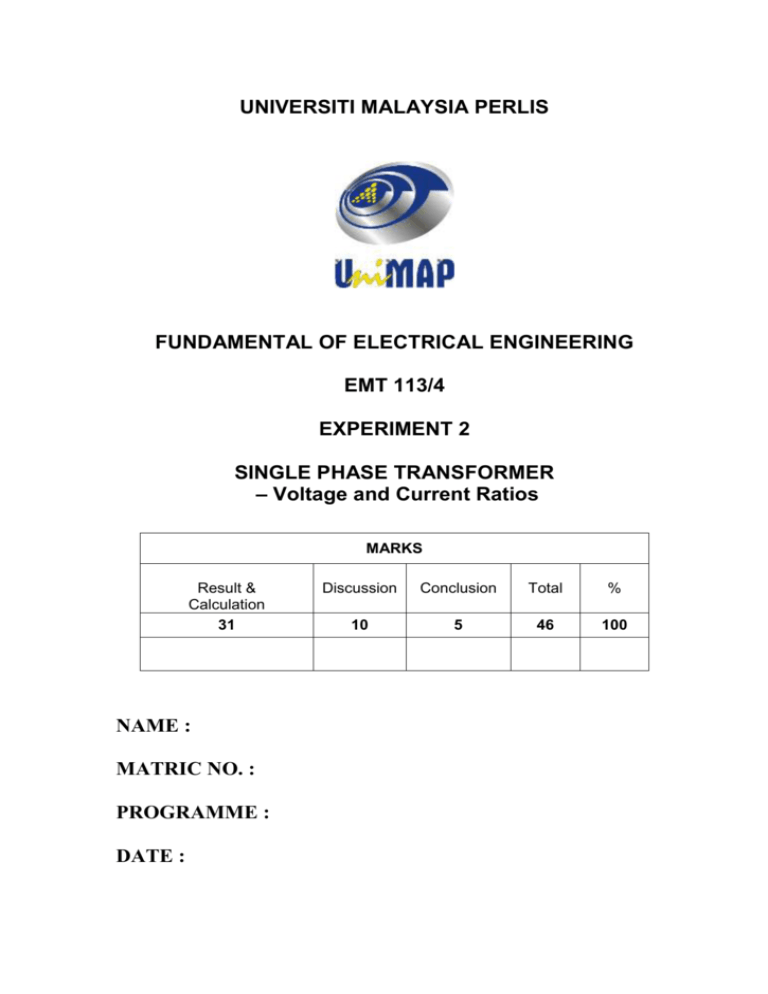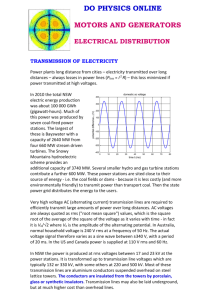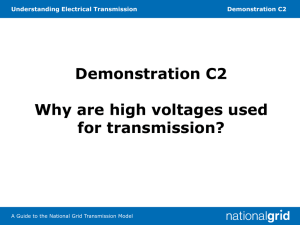Experiment 2 - Single Phase Transformer
advertisement

UNIVERSITI MALAYSIA PERLIS FUNDAMENTAL OF ELECTRICAL ENGINEERING EMT 113/4 EXPERIMENT 2 SINGLE PHASE TRANSFORMER – Voltage and Current Ratios MARKS Result & Calculation 31 NAME : MATRIC NO. : PROGRAMME : DATE : Discussion Conclusion Total % 10 5 46 100 EMT113/4 Single Phase Transformer-Voltage and Current Ratios EXPERIMENT 2 SINGLE PHASE TRANSFORMER – VOLTAGE AND CURRENT RATIOS 2.1 OBJECTIVES 1. 2. To familiar with voltage and current characteristics of a single phase transformer. To be able to use the transformer turns ratio to predict the voltage and current that will flow in the secondary winding. 2.2 EQUIPMENTS EMC Workstation Model 8110 Single Phase Transformer Model 8341 Power Supply Model 8821 Data Acquisition Interface Model 9062. 2.3 INTRODUCTION The windings of a standard single-phase transformer are called the primary winding and the secondary winding. The primary winding is the power input winding and this is the side that is connected to the ac power source. The secondary winding is connected to the load and is physically and electrically isolated from the primary. The voltage and current that flow in the secondary are related to the primary voltage and current by the transformer turns ratio N1/N2 (or Np/Ns) through a very simple relationship. The ratio of primary voltage to secondary voltage equals N1/N2, while the ratio of the primary to secondary is equal to the inverse of the turns ratio, N2/N1. This result in the following, EPRI = N1 ESEC N2 which gives: ESEC = EPRI X N2 N1 and IPRI = N2 ISEC N1 which gives: ISEC = IPRI N1 N2 X PUSAT PENGAJIAN KEJURUTERAAN MIKROELEKTRONIK 1 EMT113/4 2.4 Single Phase Transformer-Voltage and Current Ratios PROCEDURE CAUTION High voltages are present in this laboratory exercise! Do not make or modify any banana jack connections with the power on unless otherwise specified! Figure 2-1: Single –Phase Transformer Measurements 1. Install the Power Supply, Data Acquisition Interface (DAI) and Single-Phase Transformer modules in the EMS Workstation. 2. Make sure that the main switch of the Power Supply is set to the O (OFF) position, and the voltage control knob is turned fully counter clock-wise (ccw). Set the voltmeter select switch to the 4-N position. 3. Ensure that the DAI LOW POWER INPUT is connected to the main Power Supply, set the 24V-AC power switch to the 1 (ON) position. 4. Display the Metering application. 5. Set up the transformer circuit shown in Figure 2-1. Connect E1 and I1 as shown and use E2 to measure the different secondary voltages. PUSAT PENGAJIAN KEJURUTERAAN MIKROELEKTRONIK 2 EMT113/4 Single Phase Transformer-Voltage and Current Ratios 6. Turn on the power and adjust the voltage control for the value of Es given in Figure 2-1. Measure the transformer primary current (IPRI) and the different terminal voltages (E1-2, E3-4, E5-6, E3-7, E7-8, E8-4, E5-9, E9-6). [Modify each connection for different terminal voltages and record each reading]. After recording the measurements, rotate the voltage control fully ccw and then turn off the power. Note: When measuring the various voltages, turn off the Power Supply before modifying the connections of the DAI to the circuit. Figure 2-2: Determining the ratio of Primary Current to Secondary Current 7. Connect I2 as shown in Figure 2-2 and note that it short-circuits secondary winding 5-6. Turn on the power and slowly adjust the voltage control to obtain the value of current Is given in Figure 2-2. 8. Record the values of primary voltage (EPRI) and current (IPRI) and the value of the short-circuit secondary current (ISEC) in winding 5-6. 9. Return the voltage control to zero and turn off the power. Calculate the ratio of primary current to secondary current. Show your calculations. 10. Replace the connection I2 to terminals 3-4. Turn on the Power Supply and slowly adjust the voltage control knob for the same value of current used in step 7. Once again, record the values of primary voltage (EPRI) and current (IPRI) and the secondary winding current (ISEC). 11. Return the voltage control to zero and turn off the power. Again, calculate the ratio of primary current to secondary current. Show your calculations. PUSAT PENGAJIAN KEJURUTERAAN MIKROELEKTRONIK 3 EMT113/4 Single Phase Transformer-Voltage and Current Ratios Figure 2-3: Effect of Core Saturating on Exciting Current Table 2.1: Impedance Table for the Load Modules Impedance Ω Switch positions for load elements 240V 50 Hz 1 2 3 4 5 6 7 8 9 400 | - | | | | - - - 12. Set up the transformer circuit shown in Figure 2-3. It will be used to show how exciting current is affected when the transformer core becomes saturated. Since the exciting current is so small, the corresponding voltage across a sense resistor R will be used to illustrate its variation. Connect the transformer primary terminals to Power Supply terminals 4 and 5 through sense resistor R (refer to Table 2.1 for impedance configurations). Connect E1, E2 and E3 to measure the transformer voltages. 13. Turn on the power and use the output voltage control to obtain values for E2 equally spaced at about 10% intervals over the complete control knob range. At each voltage adjustment, click the Record Data button to enter the measurements in the Data Table. Then, record your data. 14. When all data values have been recorded, rotate the voltage control fully ccw, and turn off the Power Supply. 15. Display the Graph screen, select E1 as the X-axis parameter and E2 as the Yaxis parameter. Click the Line Graph button to observe the curve of primary voltage versus exciting current, represented by E1. Then copy this graph into PUSAT PENGAJIAN KEJURUTERAAN MIKROELEKTRONIK 4 EMT113/4 Single Phase Transformer-Voltage and Current Ratios the graph paper provided with appropriate scale, correct axis parameters and graph title. 16. Ensure that the Power Supply is turned off, the voltage control is fully ccw and remove all leads and cables. 2.5 RESULTS Note: Your results should include: 1) Transformer primary current and the different terminal voltages. (4.5 M) 2) Values of primary voltage (EPRI) and current (IPRI) and the value of the shortcircuit secondary current (ISEC) in both short circuit secondary terminal 5-6 and 34. (3 M) 3) The ratio of primary current to secondary current for the two cases above, and compare results with turn ratios. (4 M) 4) Table for Transformer voltages. 5) Graph 2.6 (16M) (3M) DISCUSSION (10M) Analyze your result. Discuss the voltage and current ratios for a single transformer. 2.7 CONCLUSION (5M) Make your overall conclusion by referring to the objective of this experiment (your answer should be in simple notes) PUSAT PENGAJIAN KEJURUTERAAN MIKROELEKTRONIK 5








